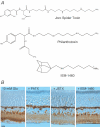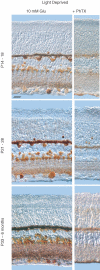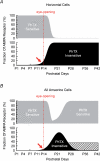Light triggers expression of philanthotoxin-insensitive Ca2+-permeable AMPA receptors in the developing rat retina
- PMID: 17430992
- PMCID: PMC2075288
- DOI: 10.1113/jphysiol.2007.127894
Light triggers expression of philanthotoxin-insensitive Ca2+-permeable AMPA receptors in the developing rat retina
Abstract
Ca2+-permeable AMPA receptors (AMPARs) are expressed throughout the adult CNS but yet their role in development is poorly understood. In the developing retina, most investigations have focused on Ca2+ influx through NMDARs in promoting synapse maturation and not on AMPARs. However, NMDARs are absent from many retinal cells suggesting that other Ca2+-permeable glutamate receptors may be important to consider. Here we show that inhibitory horizontal and AII amacrine cells lack NMDARs but express Ca2+-permeable AMPARs. Before eye-opening, AMPARs were fully blocked by philanthotoxin (PhTX), a selective antagonist of Ca2+-permeable AMPARs. After eye-opening, however, a subpopulation of Ca2+-permeable AMPARs were unexpectedly PhTX resistant. Furthermore, Joro spider toxin (JSTX) and IEM-1460 also failed to antagonize, demonstrating that this novel pharmacology is shared by several AMPAR channel blockers. Interestingly, PhTX-insensitive AMPARs failed to express in retinae from dark-reared animals demonstrating that light entering the eye triggers their expression. Eye-opening coincides with the consolidation of inhibitory cell connections suggesting that the developmental switch to a Ca2+-permeable AMPAR with novel pharmacology may be critical to synapse maturation in the mammalian retina.
Figures











Comment in
-
A light switch controlling Ca2+-permeable AMPA receptors in the retina.J Physiol. 2007 Jul 1;582(Pt 1):3. doi: 10.1113/jphysiol.2007.135145. Epub 2007 Apr 26. J Physiol. 2007. PMID: 17463033 Free PMC article. No abstract available.
Similar articles
-
A light switch controlling Ca2+-permeable AMPA receptors in the retina.J Physiol. 2007 Jul 1;582(Pt 1):3. doi: 10.1113/jphysiol.2007.135145. Epub 2007 Apr 26. J Physiol. 2007. PMID: 17463033 Free PMC article. No abstract available.
-
Fast neurotransmitter release triggered by Ca influx through AMPA-type glutamate receptors.Nature. 2006 Oct 12;443(7112):705-8. doi: 10.1038/nature05123. Epub 2006 Oct 1. Nature. 2006. PMID: 17036006
-
Sustained Ca2+ entry elicits transient postsynaptic currents at a retinal ribbon synapse.J Neurosci. 2003 Nov 26;23(34):10923-33. doi: 10.1523/JNEUROSCI.23-34-10923.2003. J Neurosci. 2003. PMID: 14645488 Free PMC article.
-
Redefining the classification of AMPA-selective ionotropic glutamate receptors.J Physiol. 2012 Jan 1;590(1):49-61. doi: 10.1113/jphysiol.2011.221689. Epub 2011 Nov 21. J Physiol. 2012. PMID: 22106175 Free PMC article. Review.
-
Synapse Type-Dependent Expression of Calcium-Permeable AMPA Receptors.Front Synaptic Neurosci. 2018 Oct 12;10:34. doi: 10.3389/fnsyn.2018.00034. eCollection 2018. Front Synaptic Neurosci. 2018. PMID: 30369875 Free PMC article. Review.
Cited by
-
Calcium-permeable AMPA receptors on AII amacrine cells mediate sustained signaling in the On-pathway of the primate retina.Cell Rep. 2022 Oct 11;41(2):111484. doi: 10.1016/j.celrep.2022.111484. Cell Rep. 2022. PMID: 36223749 Free PMC article.
-
Polyamine-mediated channel block of ionotropic glutamate receptors and its regulation by auxiliary proteins.J Biol Chem. 2018 Nov 30;293(48):18789-18802. doi: 10.1074/jbc.TM118.003794. Epub 2018 Oct 17. J Biol Chem. 2018. PMID: 30333231 Free PMC article. Review.
-
Elevated Pressure Increases Ca2+ Influx Through AMPA Receptors in Select Populations of Retinal Ganglion Cells.Front Cell Neurosci. 2018 Jun 13;12:162. doi: 10.3389/fncel.2018.00162. eCollection 2018. Front Cell Neurosci. 2018. PMID: 29950974 Free PMC article.
-
Auxiliary Subunit GSG1L Acts to Suppress Calcium-Permeable AMPA Receptor Function.J Neurosci. 2015 Dec 9;35(49):16171-9. doi: 10.1523/JNEUROSCI.2152-15.2015. J Neurosci. 2015. PMID: 26658868 Free PMC article.
-
Diabetic hyperglycemia reduces Ca2+ permeability of extrasynaptic AMPA receptors in AII amacrine cells.J Neurophysiol. 2015 Sep;114(3):1545-53. doi: 10.1152/jn.00295.2015. Epub 2015 Jul 8. J Neurophysiol. 2015. PMID: 26156384 Free PMC article.
References
-
- Aizenman E, Karschin A, Lipton SA. Two pharmacological classes of quisqualate-induced electrical responses in rat retinal ganglion cells in vitro. Eur J Pharmacol. 1989;174:9–22. - PubMed
-
- Bellone C, Luscher C. Cocaine triggered AMPA receptor redistribution is reversed in vivo by mGluR-dependent long-term depression. Nat Neurosci. 2006;9:636–641. - PubMed
-
- Bowie D, Bähring R, Mayer ML. Block of kainate and AMPA receptors by polyamines and arthropod toxins. In: Jonas P, Monyer H, editors. Handbook of Experimental Pharmacology; Ionotropic Glutamate Receptors in the CNS. Berlin: Springer-Verlag; 1999. pp. 251–373.
Publication types
MeSH terms
Substances
Grants and funding
LinkOut - more resources
Full Text Sources
Miscellaneous

